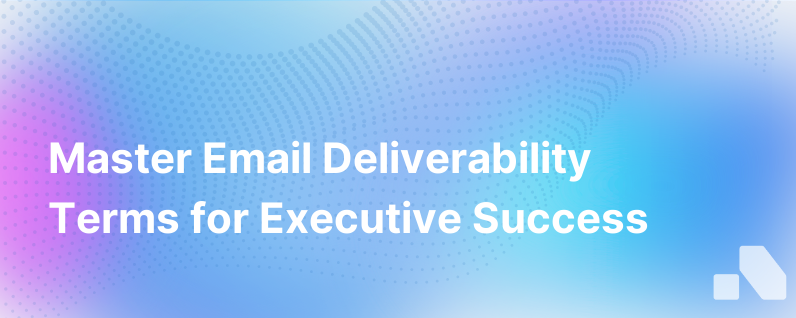Email Deliverability Terms
Published on December 24, 2023 by Sawyer Middeleer
In the constantly evolving landscape of digital marketing, email remains a cornerstone for reaching and nurturing potential customers. Email marketing is only as powerful as its deliverability, which can be a complex arena, riddled with specific terms that may convolute the understanding for those new to the space. Email deliverability dictates whether your email reaches the inbox, the spam folder, or fails to be delivered at all. Understanding these terms is pivotal to not only launching successful email campaigns but also ensuring they land in front of the intended recipients.
Below is a comprehensive lexicon of key terms and definitions essential to mastering email deliverability.
SMTP (Simple Mail Transfer Protocol)
SMTP is the standard protocol used for sending emails across the internet. Think of this as the postman of the digital world, handling the delivery of your message from point A (your email server) to point B (the recipient's email server).
MX Record (Mail Exchange Record)
The MX Record is part of a domain's DNS (Domain Name System) settings and specifies the mail server responsible for accepting email on behalf of the domain. It's a critical component in ensuring your emails find their way to the correct server.
DKIM (DomainKeys Identified Mail)
This is an authentication method used to help protect both email senders and recipients from spoofing and phishing. DKIM provides a digital signature that verifies the email was not tampered with during transit and that it indeed comes from the domain it claims to be from.
SPF (Sender Policy Framework)
SPF is another email authentication technique that prevents spammers from sending messages on behalf of your domain. It does this by verifying that incoming mail from a particular domain is being sent from servers authorized by the domain owner.
DMARC (Domain-based Message Authentication, Reporting & Conformance)
DMARC is an email authentication protocol built on top of DKIM and SPF. It allows domain owners to protect their domain from unauthorized use and improve the overall deliverability of their emails. It also provides reports that tell the domain owner who is sending email on their behalf.
Bounce Rate
Bounce rate represents the percentage of sent emails that could not be delivered to the recipient's inbox. Bounces are categorized as either soft or hard. A soft bounce might occur due to a temporary issue, like a full inbox, while a hard bounce occurs when the email address is invalid or blocked.
Whitelisting
This is the process of having your IP address or domain added to a recipient's list of approved senders. It is equivalent to being on the VIP list of email marketing — your messages are given a clear path to the intended inbox.
Blacklisting
Conversely, blacklisting is when your IP address or domain is placed on a list that denotes it as a suspected source of spam. Emails from blacklisted entities are often blocked or filtered into spam folders.
Feedback Loop (FBL)
A feedback loop is a service offered by some ISPs (Internet Service Providers) that informs senders when a recipient marks an email as spam. This is valuable feedback for marketers to adjust their strategies and maintain good sender reputations.
Sender Reputation
Your sender reputation is a score assigned by an ISP to your sending IP address. It is based on a number of factors, including but not limited to the number of emails sent, bounce rates, spam complaints, and engagement with the sent emails.
Email Throttling
This happens when an ISP limits the number of emails it accepts from a sender at one time. Throttling can be a response to a sudden spike in email volume, which is often viewed as spammy behavior.
IP Warming
IP warming is the process of gradually increasing the volume of mail sent with a dedicated IP address according to a predetermined schedule. This is important to avoid spam filters and build a positive sender reputation with ISPs.
List Hygiene
List hygiene is the practice of keeping an email list clean by removing dormant or unengaged subscribers and correcting or deleting invalid email addresses. Regular list maintenance improves deliverability and engagement rates.
CAN-SPAM Act
The CAN-SPAM Act is a law that sets the rules for commercial email. It establishes requirements for commercial messages, gives recipients the right to have you stop emailing them, and spells out tough penalties for violations.
Deliverability Rate
Deliverability rate is the percentage of emails that are accepted by the recipient server – note that accepted does not necessarily mean it landed in the inbox. It's a key performance indicator in the assessment of your email campaign’s health.
Open Rate
The open rate is a measure of how many people on an email list open or view a particular email campaign. It’s a direct indicator of how well your subject line performs and how engaged your subscribers are.
Click-Through Rate (CTR)
CTR is the ratio of users who click on a specific link to the number of total users who view the email. It is used to gauge the success of an email campaign and the interest level of the content provided.
List Segmentation
This is the practice of dividing your email subscriber list into smaller segments based on set criteria. Segmentation is often used to personalize messages and send relevant content to subgroups within your list, thus improving engagement rates.
In conclusion, understanding these email deliverability terms is essential for email marketing success. These concepts are the nuts and bolts behind getting your emails seen, opened, and acted upon. For businesses leveraging automated marketing platforms, these definitions should become part of your working vocabulary.
Indeed, professional platforms that specialize in nuanced, AI-driven email strategies — like Aomni, for instance — integrate these principles seamlessly into their services, offering peace of mind and an increase in your overall campaign effectiveness. By ensuring that your emails actually reach your audience, you set the stage for meaningful engagement and long-term customer relationships.